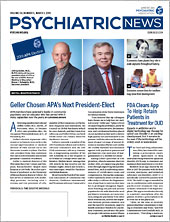Many people might say they can’t live without their smartphones, but they probably could manage without if they had to. For young people who are homeless or in transitional housing, mobile phones can truly be a lifeline.
“For youth without a physical address, a virtual address becomes that much more important,” said Niranjan Karnik, M.D., Ph.D., the Cynthia Oudejans Harris Professor of Psychiatry at Rush Medical College in Chicago. “Smartphones are usually their only connection to the world.”
Recognizing that mobile phones might also be able to serve as conduits to mental health services for homeless youth, Karnik along with Alyson Zalta, Ph.D., at Rush and Stephen Schueller, Ph.D., at nearby Northwestern University, launched a program known as Project Stepping Stone. (Zalta and Schueller are now faculty at the University of California, Irvine).
The basic concept of Stepping Stone is straightforward: homeless youth who enroll are provided a new smartphone (donated by the mobile provider Sparrow Mobile) preloaded with a data plan and several free wellness and resource apps. For example, there is an app called StreetLight Chicago, which provides up-to-date information on local shelters, health clinics, and emergency contacts, as well as alerts on weather emergencies and other issues vital to youth living on the street.
In the first phase of the program, which lasted one month, the 35 Chicago-area youth involved could also arrange up to three 30-minute phone calls with a therapist. However, given the youth’s erratic schedules, scheduling the calls was difficult, said Zalta.
“[This finding] encouraged us to try a completely automated system of intervention,” said Zalta. For the second phase of the pilot study, which is tracking 100 youth over six months, the phones have an app known as Pocket Helper, which provides daily text messages with mood surveys for the youth to complete and therapeutic tips. Pocket Helper also gives the youth direct access to mental health resources such as the Crisis Text Line and the Illinois Warm Line (which provides text-based emotional support for non-crisis situations).
Dominika Winiarski, Ph.D., a postdoctoral fellow at Rush Medical College working with Karnik, told Psychiatric News that her team has received positive feedback about the new automated system.
“The youth said that they liked reflecting on their mental health through these surveys, while the tips helped them control their emotions during moments of stress,” she said.
Zalta said that positive feedback from the youth is important, since many of them had negative perceptions or experiences with mental health care going into the study. It also helps to address concerns voiced by skeptics who wondered if youth would take advantage of mental health resources offered on the smartphones. “This feedback tells us youth very much want resources to address their mental health concerns,” she said.
Karnik, who has taken an interest in homelessness since his graduate research in India, said that the researchers recognize mental health support is only one of several key needs of homeless youth. “These kids need stable housing, absolutely. However, for most of these kids, the first type of housing available to them involves being in a group setting. And if they have emotional and interpersonal difficulties, they will have trouble adjusting in a group home, and that reduces their chances to transition to more permanent housing,” he said.
A primary goal of Stepping Stone, therefore, is to provide youth with stability in their personal lives so they can achieve stability in other areas, be it housing, school, or employment. The program makes use of the youth’s natural proclivity toward smartphone technology, but the investigators make clear the phones are not standalone solutions.
“We are not trying to replace traditional mental health services with mobile therapy,” Winiarski said. “These devices are a bridge to better care.”
Zalta said it is difficult to quantify how well the phone-based resources have performed in terms of improving mood or anxiety in the youth, in part because the youth continue to live in a harsh environment. “In our first phase, 45 percent of the participants reported at least one traumatic experience during the month-long intervention,” she said. “That might offset any potential gains they had achieved.”
As part of the pilot’s second phase, the investigators are conducting focus groups with the youth to evaluate the feasibility and acceptability of these mobile interventions. They want to wait until they complete this six-month evaluation before they conduct any long-term planning.
Winiarski also noted that an infrastructure to support the broad implementation of a project like Stepping Stone needs to be built up. While the participants in the study are given a six-month cellular data plan, that may be difficult on a large scale, which means the youth would need suitable Wi-Fi access. While some shelters like Chicago’s Night Ministry (which helped with recruitment) have adequate Wi-Fi service and charging stations, many do not. Another consideration would be secure storage lockers for youth to safely store their phones.
Winiarski is optimistic that a phone-based intervention program for homeless individuals can be successful. “For most of us, being ‘disconnected’ from our phones is an exception rather than the rule. It is rewarding to see how excited these youth get once they feel connected with the world,” she said.
“Recently, someone told me it was great that they could finally call their boss and let them know if they would be late for work, as opposed to asking their case manager to do it for them or having to find someone else with access to a phone,” she continued. “It seems like such a small thing, but for that person, it was a big step toward independence and better well-being.”
In addition to the contributions by Sparrow Mobile and the Night Ministry, Stepping Stone was made possible with support from Hedge Funds Care/Help for Children (phase one) and the Illinois Department of Human Services (phase 2). ■

